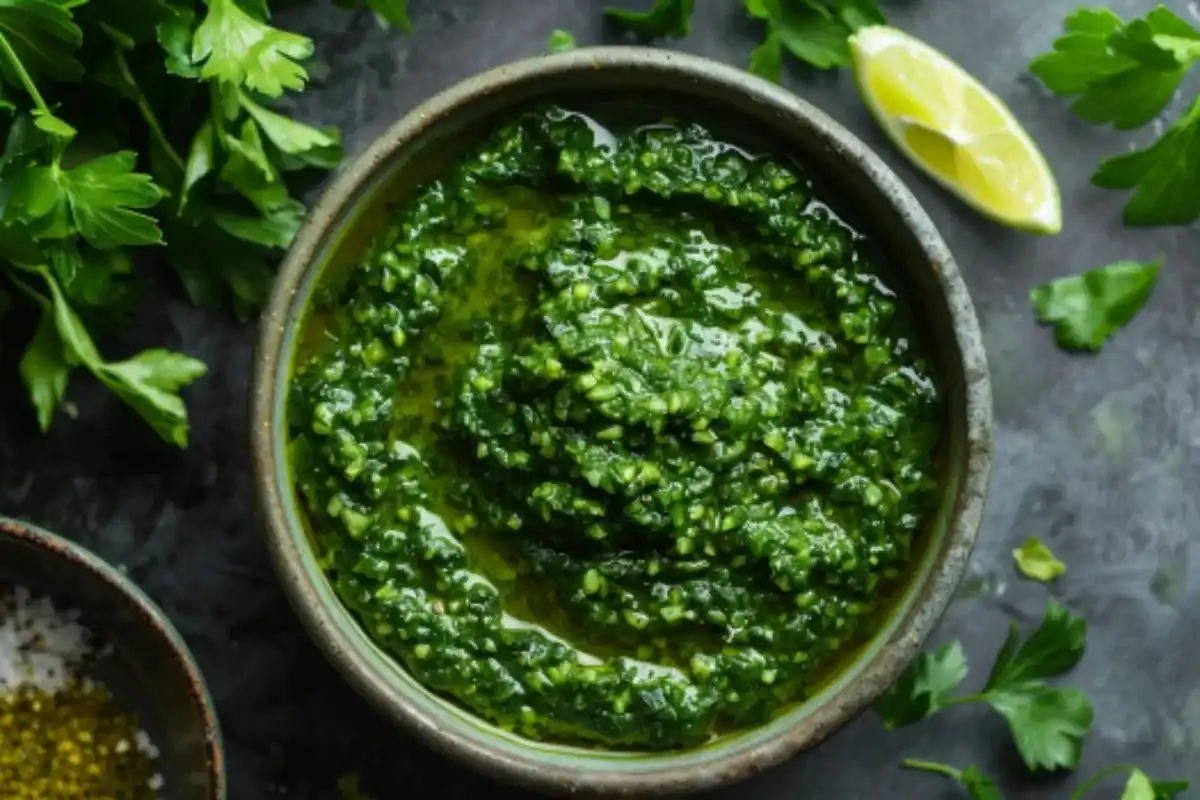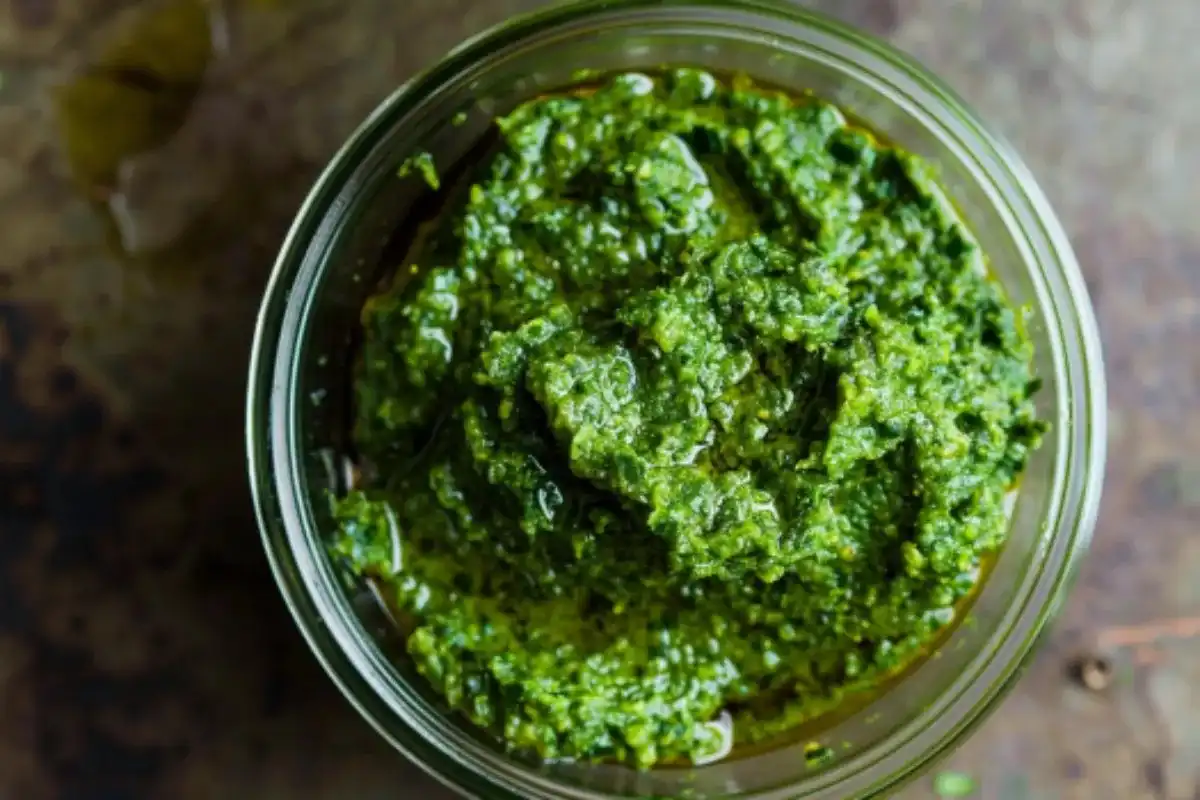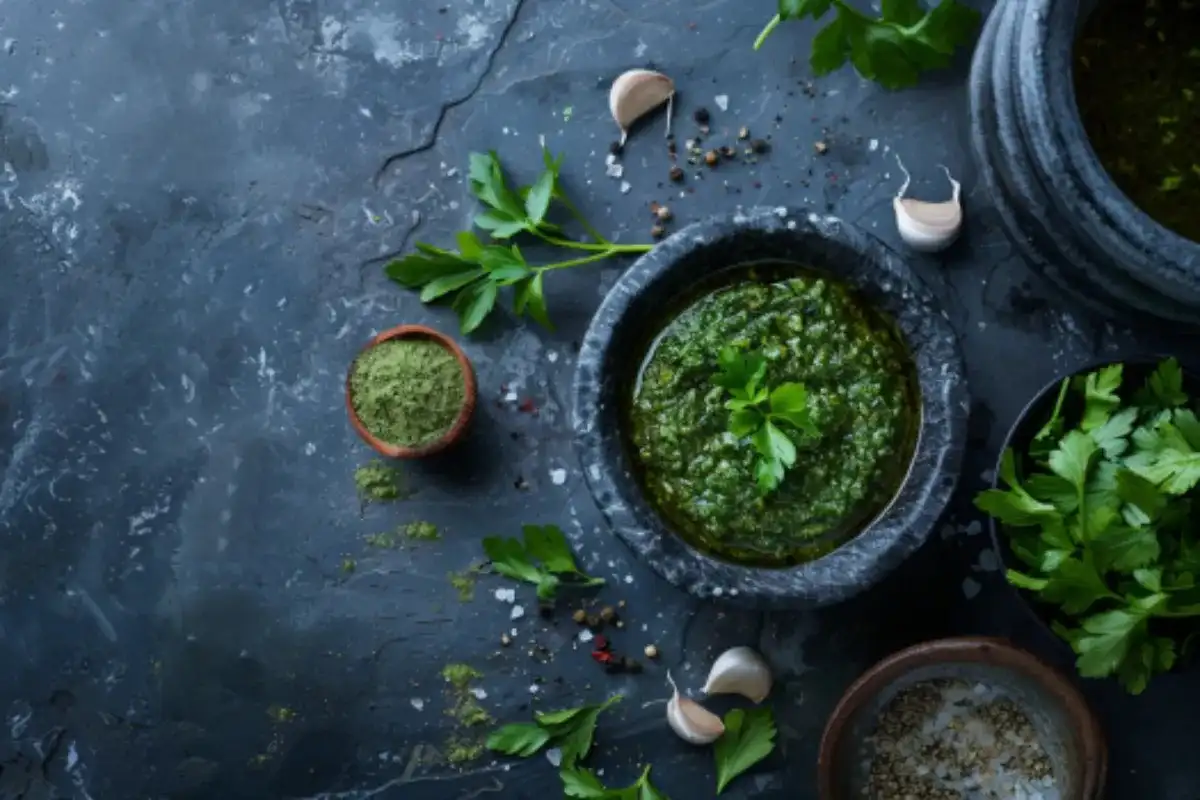Skhug and Green Harissa are two vibrant green sauces that have found their way into the kitchens of food enthusiasts around the world. While they may appear similar at first glance, these sauces originate from different culinary traditions and have unique flavors, ingredients, and preparation methods that set them apart. Skhug hails from the Middle East, particularly from Yemeni and Israeli cuisines, while Green Harissa has its roots in North Africa, primarily Tunisia and Morocco. This article will explore these differences in detail, including their origins, core ingredients, preparation methods, and distinct culinary applications.
Origins: Skhug vs. Green Harissa
The Difference in Origins: Skhug’s Middle Eastern Background

Skhug, sometimes spelled zhug or zhoug, is a fiery condiment that originated in Yemen. It is believed to have been brought to Israel by Yemeni Jews in the early 20th century and has since become a staple in Israeli cuisine. Traditionally, Skhug was made with ingredients that were readily available in Yemen: fresh green chilies, garlic, cilantro, parsley, cumin, and coriander. The use of these fresh herbs and spices gave the sauce its characteristic bright green color and intense flavor profile.
In Yemeni culture, Skhug is often served alongside dishes such as malawach (a flaky bread), lachuch (a type of Yemeni pancake), or kubaneh (a slow-cooked bread). The sauce’s popularity spread throughout the Middle East, and it became a common accompaniment to dishes like falafel, shawarma, and grilled meats in Israeli cuisine. To explore more about how Skhug fits into the broader context of Middle Eastern flavors, you might enjoy our article on Skhug Sauce Guide.
Green Harissa: A North African Staple
Green Harissa, on the other hand, has its roots in North Africa, particularly in Tunisia and Morocco. Harissa, in general, is a popular sauce in the Maghreb region, but Green Harissa is less well-known than its red counterpart, which is made primarily with red chilies. Green Harissa is prepared using fresh green herbs and spices such as cilantro, parsley, coriander, and cumin, along with green chilies and garlic. Its preparation may also include ingredients like preserved lemon and mint, which add complexity to its flavor.
In North African cuisine, Green Harissa is a versatile condiment that enhances the flavors of various dishes. It is commonly used in couscous, tagines, grilled fish, and meat dishes. The sauce adds a burst of fresh, herby heat and is integral to the flavors of North African cuisine. For more insights into how sauces like Green Harissa shape North African dishes, see our guide on North African Culinary Traditions.
Ingredients and Preparation Methods
Core Ingredients of Skhug
Skhug is celebrated for its simplicity and freshness. The core ingredients of Skhug are green chilies, garlic, fresh cilantro, parsley, ground cumin, coriander seeds, olive oil, and lemon juice. These ingredients are typically blended or finely chopped to create a chunky sauce. The use of fresh chilies gives Skhug its characteristic heat, while the herbs provide a bright, aromatic quality.
- Green Chilies: The heat level in Skhug is primarily determined by the type and quantity of green chilies used. Serrano or jalapeño peppers are common choices. The seeds and membranes can be removed or included, depending on the desired spiciness.
- Garlic: Fresh garlic adds a sharp, pungent flavor that complements the heat of the chilies and the freshness of the herbs.
- Fresh Herbs: Cilantro and parsley are the primary herbs used in Skhug. Cilantro adds a citrusy, slightly peppery note, while parsley balances with a mild, slightly bitter flavor.
- Spices: Ground cumin and coriander seeds are essential spices in Skhug. Cumin adds warmth and earthiness, while coriander offers a subtle sweetness and citrusy undertone.
- Olive Oil and Lemon Juice: Olive oil adds richness and helps emulsify the sauce, while lemon juice provides acidity that balances the flavors.
The preparation of Skhug involves pulsing or blending the ingredients to create a sauce that is chunky rather than smooth. The texture is meant to be slightly coarse, allowing the individual flavors and textures of the herbs, chilies, and spices to come through. For more on making Skhug at home, check out our Skhug Sauce Ingredients guide.
Core Ingredients of Green Harissa
Green Harissa shares some ingredients with Skhug but has its own unique components that differentiate it. The core ingredients typically include green chilies, garlic, fresh herbs like cilantro, parsley, and mint, and spices such as cumin, coriander, and caraway. The inclusion of preserved lemon and mint sets Green Harissa apart from Skhug.
- Green Chilies: As with Skhug, the type of green chili used in Green Harissa can vary. It can range from mild poblano peppers to spicier varieties like jalapeños or green bird’s eye chilies.
- Garlic: Green Harissa uses garlic to add a robust flavor profile, similar to Skhug.
- Fresh Herbs: While cilantro and parsley are also staples in Green Harissa, the addition of mint is unique to this sauce. Mint adds a refreshing, cool flavor that balances the heat of the chilies.
- Spices: Green Harissa typically includes cumin, coriander, and caraway seeds. Caraway, in particular, adds a distinctive anise-like flavor that is not found in Skhug.
- Preserved Lemon: A signature ingredient in many North African dishes, preserved lemon adds a unique salty-sour flavor to Green Harissa, contributing depth and complexity to the sauce.
- Olive Oil: Olive oil is used to create a smooth paste, unlike the chunky texture of Skhug.
The preparation method for Green Harissa involves blending all the ingredients into a smooth paste. This process allows the flavors to meld together, creating a sauce that is well-balanced and cohesive. The addition of preserved lemon and mint gives Green Harissa its unique North African flair.
Flavor Profiles and Culinary Uses

Flavor Profile of Skhug
Skhug is known for its bold, intense flavors. The predominant taste is spicy, owing to the use of fresh green chilies. However, the heat is balanced by the freshness of cilantro and parsley and the bright acidity of lemon juice. The cumin and coriander add earthy and slightly sweet notes that complement the spiciness and herbaceousness of the sauce. The overall flavor profile of Skhug is fresh, vibrant, and punchy, with a pleasing heat that lingers on the palate.
The chunky texture of Skhug adds to its appeal, providing a satisfying bite that pairs well with various dishes. It is commonly used as a condiment or dip and can be drizzled over grilled meats, roasted vegetables, falafel, shawarma, and sandwiches. It also makes an excellent accompaniment to fresh bread, such as pita or challah. For a deeper dive into the various ways to use Skhug, you can explore our Skhug Sauce Guide.
Flavor Profile of Green Harissa
Green Harissa has a more complex and layered flavor profile. It combines the heat of green chilies with the herbal notes of cilantro, parsley, and mint. The mint adds a cool, refreshing quality that tempers the spiciness of the chilies. The preserved lemon introduces a salty, tangy flavor that is distinctively North African, while the caraway seeds contribute a unique anise-like taste that sets Green Harissa apart from other green sauces.
The texture of Green Harissa is smooth and paste-like, making it easy to blend into dishes or use as a marinade. It is often used in cooking to add depth and complexity to stews, tagines, and couscous dishes. It can also be used as a spread for sandwiches, a dip for vegetables, or a topping for grilled meats and seafood. To learn more about how to incorporate Green Harissa into your cooking, see our article on North African Culinary Traditions.
Comparative Culinary Uses
While both Skhug and Green Harissa are versatile sauces, they are used differently in their respective cuisines.
- Skhug’s Versatility in Middle Eastern Cuisine: Skhug is often served as a condiment alongside grilled meats, falafel, hummus, or pita bread. It adds a spicy kick to dishes like shakshuka or can be mixed with yogurt to create a cooling dip that complements spicy dishes. Its fresh, herby flavor makes it an excellent choice for dishes that benefit from a burst of bright, spicy flavor.
- Green Harissa’s Role in North African Cooking: Green Harissa, with its smooth texture and layered flavors, is commonly used as a marinade or cooking sauce in North African cuisine. It is frequently added to couscous, tagines, or vegetable dishes to provide a complex, herbaceous flavor. It can also be used as a base for sauces or spreads, or as a finishing touch to enhance grilled or roasted dishes.
For more ways to use flavorful condiments in your cooking, check out our Guide to Seasoning Ground Beef.
Making Skhug and Green Harissa at Home

Making Skhug at Home
Creating Skhug at home is quite straightforward and offers the opportunity to tailor both the heat level and flavor profile to your taste. To start, gather fresh green chilies (such as serrano or jalapeño), garlic cloves, fresh cilantro, parsley, cumin, coriander seeds, lemon juice, and olive oil. Depending on your heat preference, you can adjust the amount of chili and garlic used.
- Prepare the Ingredients: Remove the stems and seeds from the chilies (if you prefer less heat) and roughly chop them. Peel and crush the garlic cloves.
- Blend or Pulse: Combine the chilies, garlic, cilantro, parsley, ground cumin, and coriander seeds in a food processor or blender. Pulse the mixture until it is coarsely chopped, being careful not to over-process; you want a chunky texture.
- Add Olive Oil and Lemon Juice: Slowly drizzle in the olive oil while continuing to pulse the mixture. Add lemon juice and blend briefly to incorporate.
- Adjust Seasoning: Taste the Skhug and adjust seasoning as needed. You may want to add more lemon juice for acidity or salt for balance.
- Serve or Store: Skhug can be served immediately or stored in the refrigerator for up to a week. It pairs well with a variety of dishes, from roasted vegetables to grilled meats.
For a detailed step-by-step recipe, see our Skhug Sauce Ingredients guide.
Making Green Harissa at Home
Green Harissa is also easy to make at home and allows for flexibility in terms of heat and flavor. To start, gather green chilies, garlic, fresh cilantro, parsley, mint, cumin, coriander, caraway seeds, preserved lemon, and olive oil.
- Prepare the Ingredients: Chop the green chilies, peel and crush the garlic, and finely chop the fresh herbs. Rinse the preserved lemon to remove excess salt and chop finely.
- Blend Ingredients: Combine the chilies, garlic, herbs, spices, and preserved lemon in a food processor or blender. Blend until the mixture becomes a smooth paste.
- Add Olive Oil: While blending, slowly drizzle in the olive oil until the mixture emulsifies into a smooth, creamy sauce.
- Adjust Seasoning: Taste the Green Harissa and adjust the seasoning as needed. You may want to add more preserved lemon for tanginess or additional spices for flavor.
- Serve or Store: Green Harissa can be used immediately or stored in the refrigerator for up to a week. It can be used as a marinade, spread, or finishing sauce.
For more on making your own Green Harissa, check out our article on North African Culinary Traditions.
Frequently Asked Questions
1. What is the difference between Skhug and Green Harissa in terms of taste?
Skhug is typically spicier and has a chunky texture, while Green Harissa is smoother with a more complex, herbaceous flavor that includes notes of mint and preserved lemon.
2. Can I substitute one for the other in recipes?
While Skhug and Green Harissa can sometimes be used interchangeably, they have different flavor profiles and textures that may affect the outcome of the dish. Use Skhug when you want a spicier, chunkier condiment and Green Harissa for a smoother, more balanced sauce.
3. Which is spicier: Skhug or Green Harissa?
Skhug is generally spicier due to the use of fresh green chilies and the minimal inclusion of ingredients that moderate the heat. Green Harissa, while still spicy, tends to have a milder heat due to its combination of herbs and preserved lemon.
4. How long do Skhug and Green Harissa last in the fridge?
Both sauces can be stored in an airtight container in the refrigerator for up to a week. Make sure to use clean utensils to avoid contamination and extend their shelf life.
5. Are there different regional versions of these sauces?
Yes, there are many regional variations of both Skhug and Green Harissa. Different types of chilies, herbs, and spices may be used depending on local preferences and ingredient availability.
Conclusion
Skhug and Green Harissa are two flavorful, versatile sauces that offer a unique twist to any dish. While both are green and herbaceous, their distinct ingredients, preparation methods, and culinary uses make them stand out in their respective cuisines. Whether you prefer the spicy, chunky texture of Skhug or the smooth, complex flavors of Green Harissa, experimenting with these sauces is sure to bring new excitement to your cooking. Try making them at home and discover the many ways they can enhance your meals!

